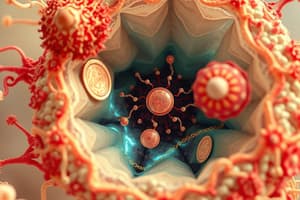Podcast
Questions and Answers
What is the definition of a pathogen?
What is the definition of a pathogen?
A pathogen is an organism that causes disease, which can include bacteria, fungi, Protoctista, and viruses.
List the common types of pathogens.
List the common types of pathogens.
Common types of pathogens include bacteria, fungi, Protoctista, and viruses.
What are the key characteristics of viruses?
What are the key characteristics of viruses?
Viruses are non-living, very small particles that can only reproduce in living cells and have a protein coat that contains either DNA or RNA.
Can viruses infect all types of living organisms?
Can viruses infect all types of living organisms?
Why are viruses considered non-living entities?
Why are viruses considered non-living entities?
What does it mean that viruses have no cellular structure?
What does it mean that viruses have no cellular structure?
Describe the composition of a virus.
Describe the composition of a virus.
How do viruses reproduce?
How do viruses reproduce?
What distinguishes animals from flowering plants in terms of cellular structure?
What distinguishes animals from flowering plants in terms of cellular structure?
How do animals store carbohydrates, and what are some examples?
How do animals store carbohydrates, and what are some examples?
In what form do fungi primarily organize their structure?
In what form do fungi primarily organize their structure?
Why are fungi unable to carry out photosynthesis?
Why are fungi unable to carry out photosynthesis?
Describe the nutritional method fungi use to obtain food.
Describe the nutritional method fungi use to obtain food.
What component makes up the cell walls of fungi?
What component makes up the cell walls of fungi?
Do fungi store carbohydrates, and if so, in what form?
Do fungi store carbohydrates, and if so, in what form?
What role do flowering plants and legumes play in the ecosystem?
What role do flowering plants and legumes play in the ecosystem?
What group does Mucor belong to and what are its characteristics?
What group does Mucor belong to and what are its characteristics?
Identify a single-celled organism with animal-like features and describe them.
Identify a single-celled organism with animal-like features and describe them.
What plant-like features are exhibited by Chlorella?
What plant-like features are exhibited by Chlorella?
Provide an example of a pathogenic organism within Protoctista.
Provide an example of a pathogenic organism within Protoctista.
Discuss the main difference between prokaryotic and protoctist organisms.
Discuss the main difference between prokaryotic and protoctist organisms.
What are the microscopic characteristics common to the Protoctista group?
What are the microscopic characteristics common to the Protoctista group?
How does the classification of Mucor help in understanding its ecological role?
How does the classification of Mucor help in understanding its ecological role?
Why are some protoctists considered pathogenic?
Why are some protoctists considered pathogenic?
What does the acronym MRS C GREN represent in terms of characteristics of living organisms?
What does the acronym MRS C GREN represent in terms of characteristics of living organisms?
What characteristic allows plants to convert sunlight into chemical energy?
What characteristic allows plants to convert sunlight into chemical energy?
How do eukaryotic organisms store carbohydrates?
How do eukaryotic organisms store carbohydrates?
What distinctive structural feature do plant cells have that is not found in animal cells?
What distinctive structural feature do plant cells have that is not found in animal cells?
Identify a key difference in nutrient acquisition between plants and animals.
Identify a key difference in nutrient acquisition between plants and animals.
Explain the significance of excretion in living organisms.
Explain the significance of excretion in living organisms.
What feature of living organisms aids in responding to environmental changes?
What feature of living organisms aids in responding to environmental changes?
Describe a characteristic shared by all eukaryotic organisms.
Describe a characteristic shared by all eukaryotic organisms.
Why is respiration essential for living organisms?
Why is respiration essential for living organisms?
How does growth manifest in living organisms?
How does growth manifest in living organisms?
What experimental methods can be used to investigate diffusion and osmosis in living systems?
What experimental methods can be used to investigate diffusion and osmosis in living systems?
Describe a technique to determine the energy content in a food sample.
Describe a technique to determine the energy content in a food sample.
Summarize the process of respiration that produces ATP in living organisms.
Summarize the process of respiration that produces ATP in living organisms.
What is the balanced chemical equation for aerobic respiration?
What is the balanced chemical equation for aerobic respiration?
Write the word equation for anaerobic respiration in animals.
Write the word equation for anaerobic respiration in animals.
How can the evolution of carbon dioxide and heat from respiring seeds be measured?
How can the evolution of carbon dioxide and heat from respiring seeds be measured?
What factors influence the rate of photosynthesis?
What factors influence the rate of photosynthesis?
Explain the role of yeast in the production of food.
Explain the role of yeast in the production of food.
What is the importance of investigating anaerobic respiration in yeast?
What is the importance of investigating anaerobic respiration in yeast?
Identify the chemical elements in carbohydrates and proteins.
Identify the chemical elements in carbohydrates and proteins.
Describe the structure of lipids.
Describe the structure of lipids.
What tests can be performed to identify the presence of glucose, starch, proteins, and fats in food samples?
What tests can be performed to identify the presence of glucose, starch, proteins, and fats in food samples?
What role do enzymes play in metabolic reactions?
What role do enzymes play in metabolic reactions?
How does temperature affect enzyme activity?
How does temperature affect enzyme activity?
Flashcards are hidden until you start studying
Study Notes
Characteristics of Living Organisms
- All living organisms share characteristics known as MRS C GREN: Movement, Respiration, Sensitivity, Control (of internal conditions), Growth, Reproduction, Excretion, and Nutrition.
Common Features of Eukaryotic Organisms
- Plants are multicellular, can carry out photosynthesis, have a cellulose cell wall, and store carbohydrates as starch or sucrose.
- Animals are multicellular, lack chloroplasts, and store carbohydrates as glycogen.
- Fungi are unable to carry out photosynthesis, are usually organised in mycelium (a network of thread-like hyphae), have chitin cell walls, feed by saprotrophic nutrition, and may store carbohydrates as glycogen.
- Protoctista are microscopic, single-celled organisms. Some, like Amoeba, have animal-like features, while others, like Chlorella, have plant-like features.
Common Features of Prokaryotic Organisms
- Bacteria are unicellular, lack a nucleus, and have a cell wall made of peptidoglycan.
Pathogens
- Pathogens are organisms that cause disease.
- Pathogens can include fungi, bacteria, Protoctista, and viruses.
Viruses
- Viruses are non-living, very small particles that can only reproduce inside living cells.
- Viruses can infect all types of living organisms.
- Viruses have no cellular structure but have a protein coat containing either DNA or RNA.
Investigating Diffusion and Osmosis
- Diffusion and osmosis can be explored using both living and non-living systems.
Investigating Energy Content in Food
- The energy content of food samples can be investigated.
Cellular Respiration and ATP
- Respiration produces ATP in living organisms.
- ATP provides energy for cells.
- Aerobic respiration has a word equation and a balanced chemical equation.
- Anaerobic respiration also has a word equation in plants and animals.
Investigating Respiration in Seeds
- The evolution of carbon dioxide and heat from respiring seeds (or other living organisms) can be investigated.
- The rate of photosynthesis is impacted by carbon dioxide concentration, light intensity, and temperature.
Yeast in Food Production
- Yeast plays a role in food production, including bread.
Anaerobic Respiration by Yeast
- Anaerobic respiration by yeast can be investigated under different conditions.
Investigating Food Samples
- Food samples can be investigated for the presence of glucose, starch, protein, and fat.
Enzymes as Biological Catalysts
- Enzymes are biological catalysts that accelerate metabolic reactions.
- The rate of enzyme activity is influenced by factors such as temperature and pH.
The Chemistry of Biological Molecules
- Carbohydrates, proteins, and lipids are large molecules made up of smaller units.
- Carbohydrates like starch and glycogen are formed from simple sugars.
- Proteins are constructed from amino acids.
- Lipids are composed of fatty acids and glycerol.
Studying That Suits You
Use AI to generate personalized quizzes and flashcards to suit your learning preferences.




